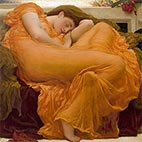
Victorian Neoclassicism and Romanticism Artists Index
Alphabetical Index of the Great Masters of the Victorian Neoclassicism and Romanticism
Victorian Neoclassicism and Romanticism are two distinct artistic movements that emerged in the late 18th and early 19th centuries in Europe, and became influential in the Victorian era (1837-1901) in England.
Neoclassicism is a movement that sought to revive the classical styles of ancient Greece and Rome. It emerged in the mid-18th century as a reaction against the ornate and flamboyant style of the Baroque period. Neoclassical artists sought to create a style that was rational, balanced, and orderly, and that emphasized the values of clarity, simplicity, and symmetry. In the Victorian era, neoclassicism was often used to convey moral and intellectual values, and was seen as a way of elevating the middle class.
Romanticism, on the other hand, was a movement that celebrated emotion, individualism, and the imagination. It emerged in the late 18th century as a reaction against the rationalism and strict rules of neoclassicism. Romantic artists sought to explore the world of the subconscious and the mystical, and often depicted powerful emotions, nature, and the exotic. In the Victorian era, romanticism was often used to convey a sense of escapism and to explore themes of the supernatural and the irrational.
Some notable Victorian neoclassical artists include Sir Lawrence Alma-Tadema, Frederic Leighton, and John William Waterhouse, who created idealized images of the classical world, often with a focus on history and mythology. In contrast, some notable Victorian romantic artists include William Blake, J.M.W. Turner, and John Constable, who explored themes of emotion, nature, and the sublime.
Overall, both neoclassicism and romanticism had a significant impact on Victorian art and culture, and helped to shape the visual language of the era.
Neoclassicism is a movement that sought to revive the classical styles of ancient Greece and Rome. It emerged in the mid-18th century as a reaction against the ornate and flamboyant style of the Baroque period. Neoclassical artists sought to create a style that was rational, balanced, and orderly, and that emphasized the values of clarity, simplicity, and symmetry. In the Victorian era, neoclassicism was often used to convey moral and intellectual values, and was seen as a way of elevating the middle class.
Romanticism, on the other hand, was a movement that celebrated emotion, individualism, and the imagination. It emerged in the late 18th century as a reaction against the rationalism and strict rules of neoclassicism. Romantic artists sought to explore the world of the subconscious and the mystical, and often depicted powerful emotions, nature, and the exotic. In the Victorian era, romanticism was often used to convey a sense of escapism and to explore themes of the supernatural and the irrational.
Some notable Victorian neoclassical artists include Sir Lawrence Alma-Tadema, Frederic Leighton, and John William Waterhouse, who created idealized images of the classical world, often with a focus on history and mythology. In contrast, some notable Victorian romantic artists include William Blake, J.M.W. Turner, and John Constable, who explored themes of emotion, nature, and the sublime.
Overall, both neoclassicism and romanticism had a significant impact on Victorian art and culture, and helped to shape the visual language of the era.